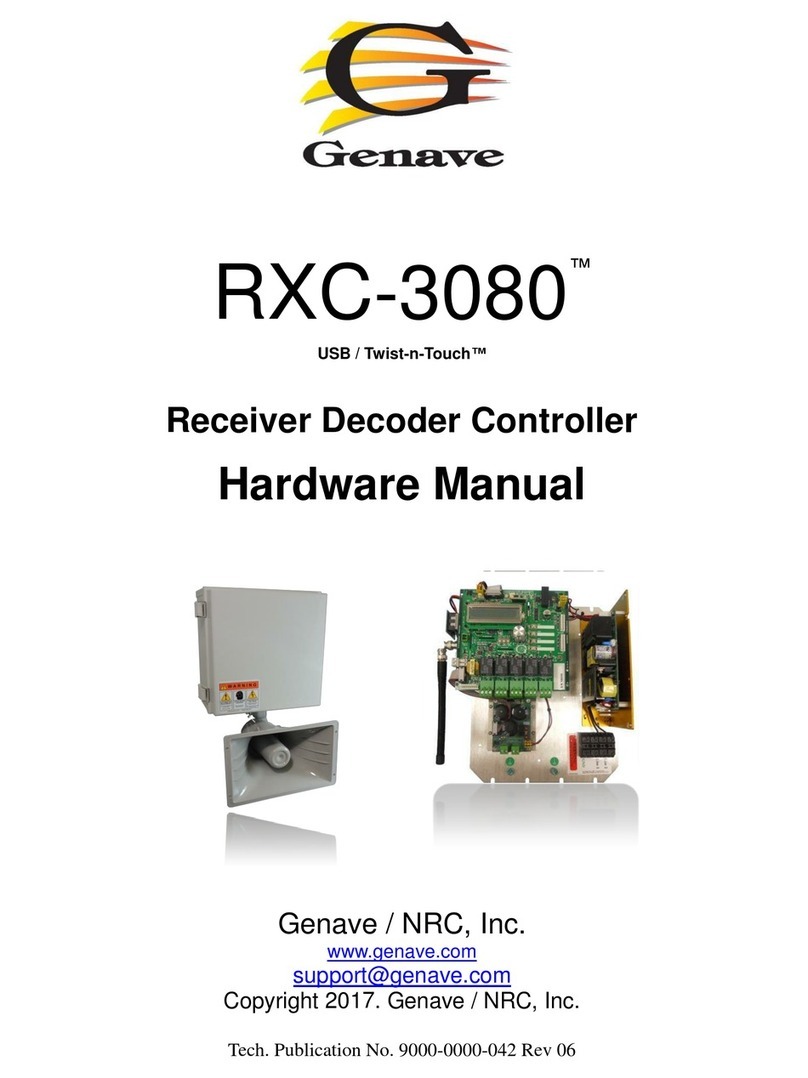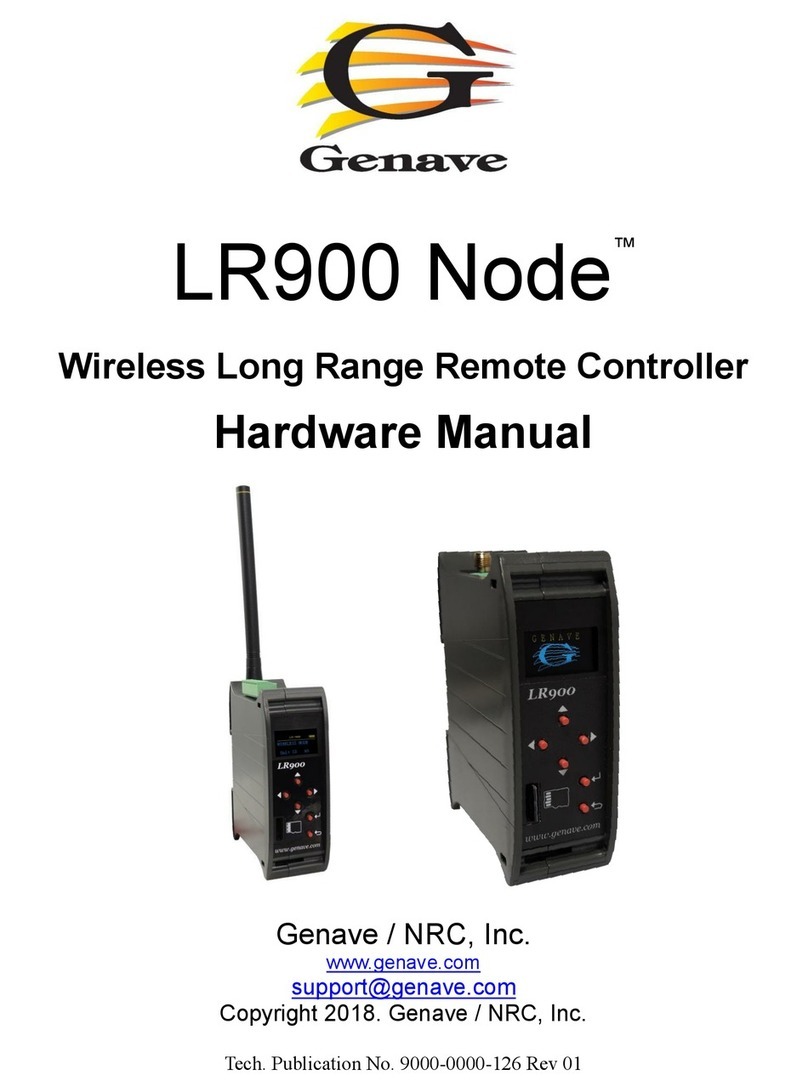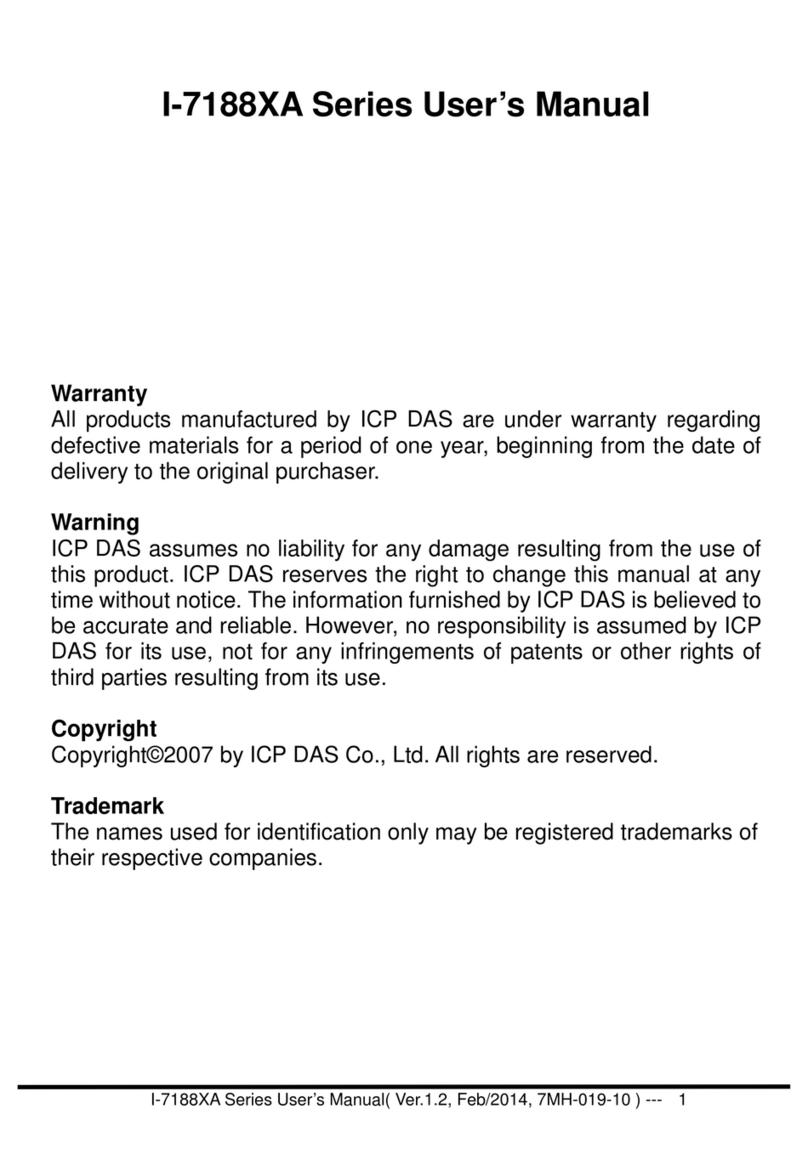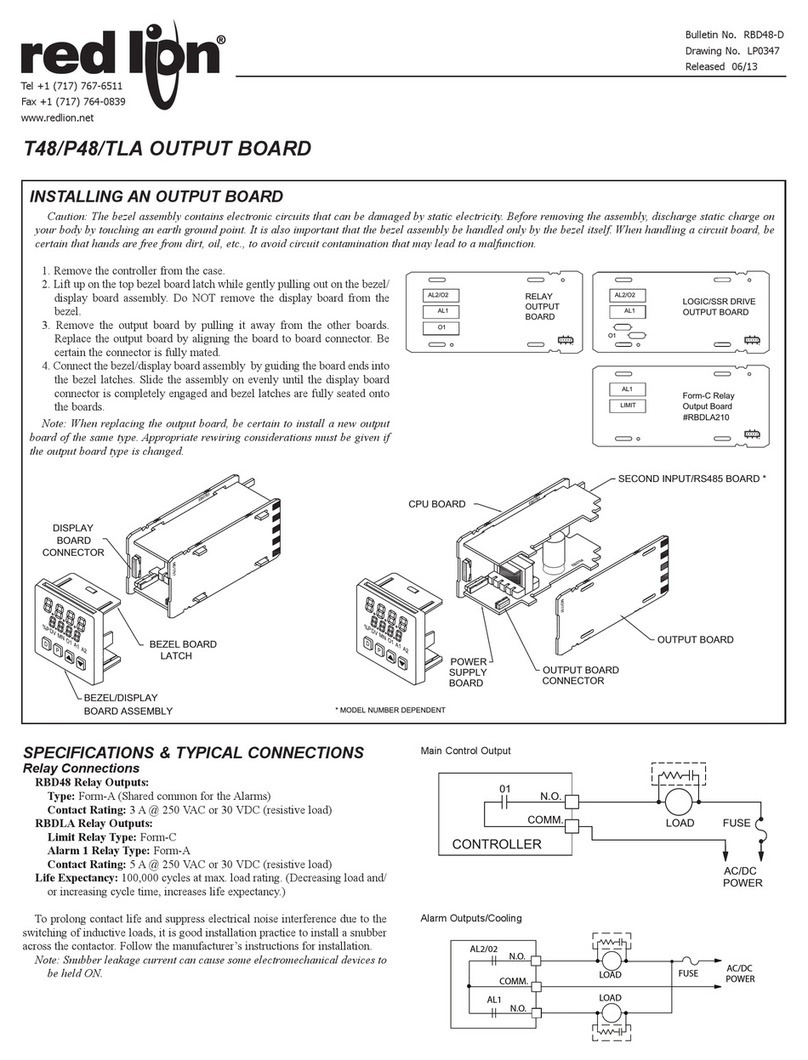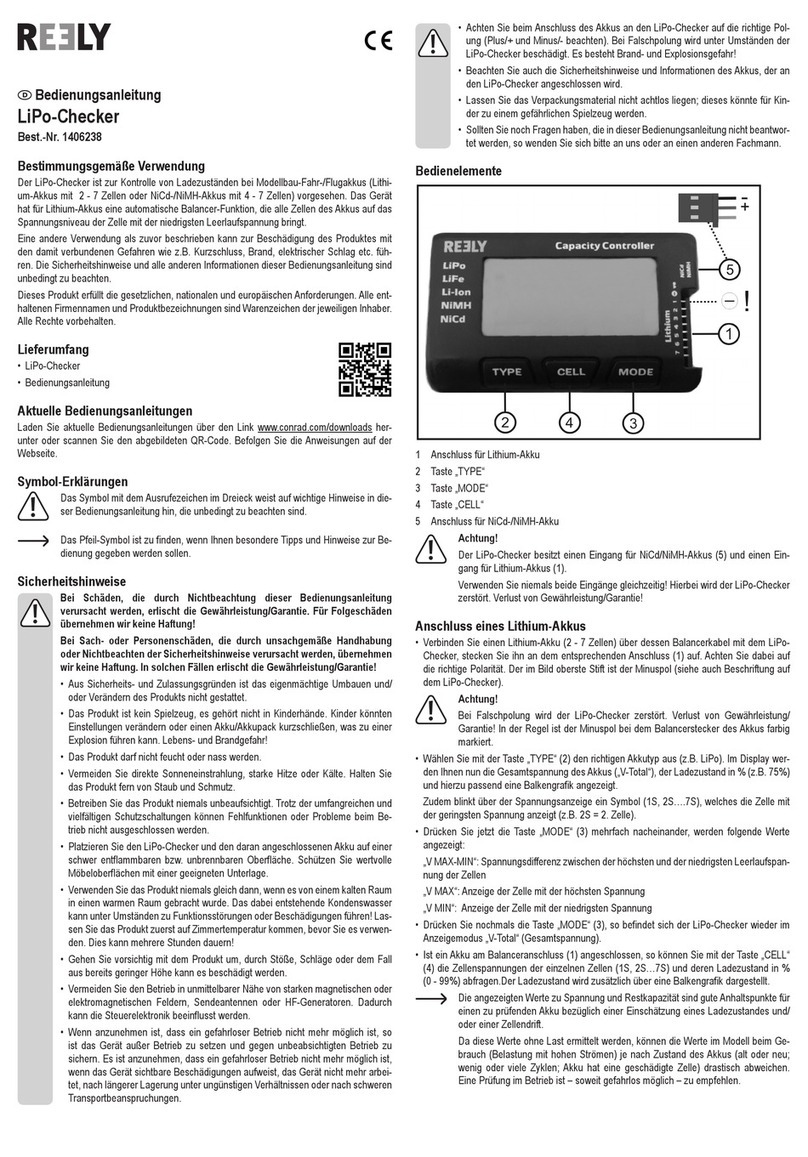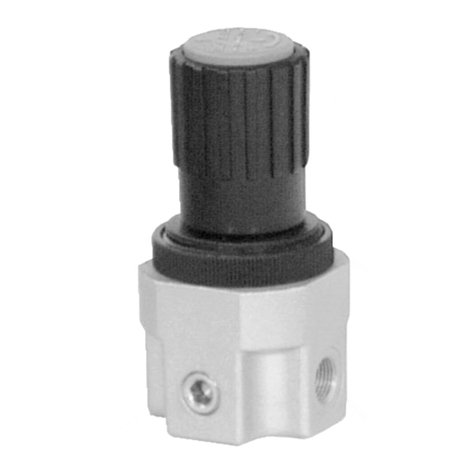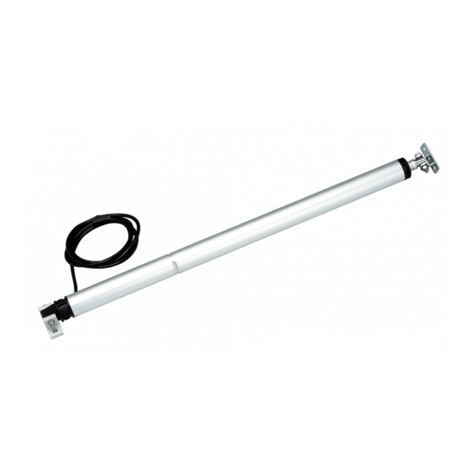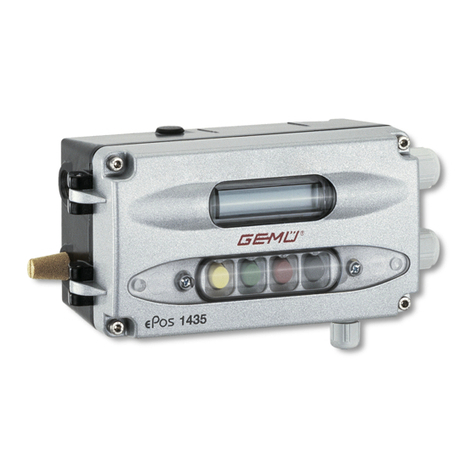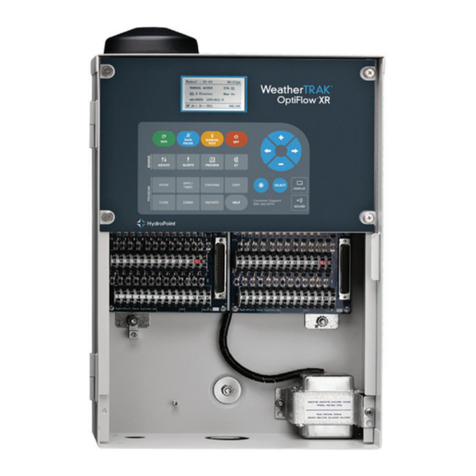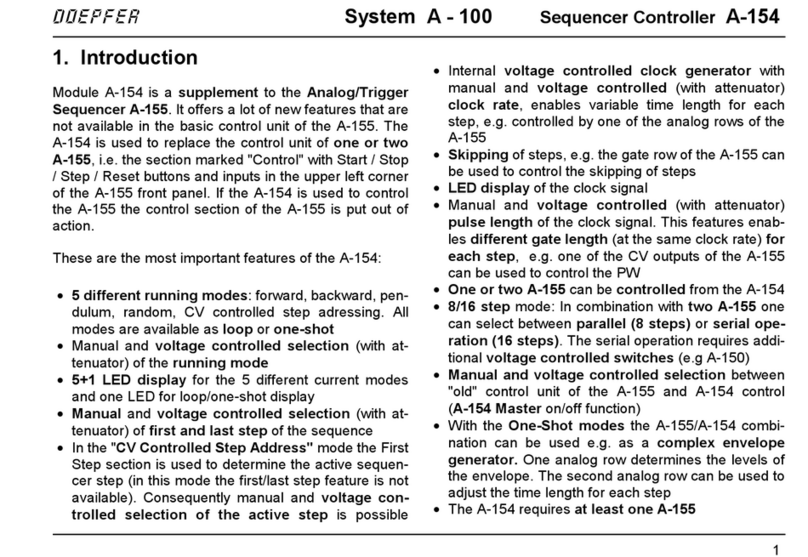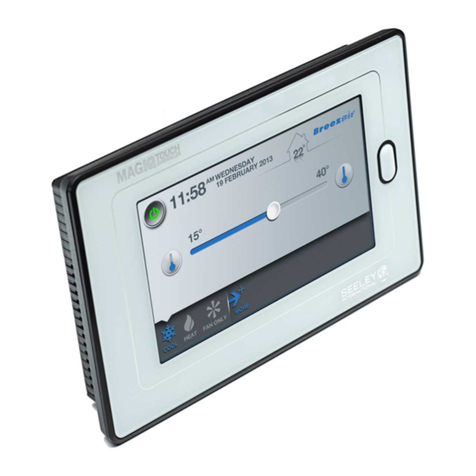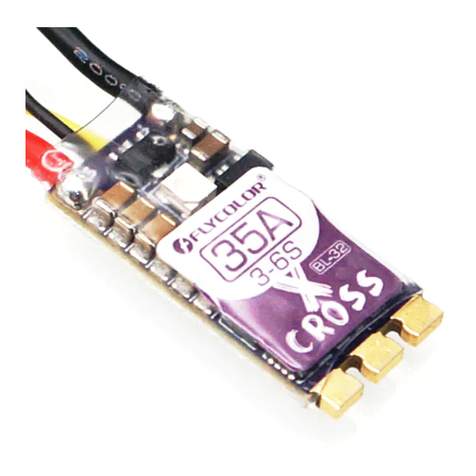Genave RXC-3000 User manual

RXC-3000 Hardware Installation and User Guide
9000-0000-040 Revision 10 2 of 46 Genave Electronics
Important Safety Information
System Planning
Proper planning is the cornerstone to an effective warning system. The Federal
Emergency Management Agency (FEMA) publishes the “Outdoor Warning Guide” CPG
1-17, which should be used in planning your system. In addition, you should recognize
and understand the following items:
Outdoor warnings sirens and equipment are not intended to be heard indoors.
Conversely indoor devices are not intended to cover outdoor environments. All
devices have specific purposes and distances that they can be considered effective.
Proper placement and selection of the correct equipment is necessary to cover a
desired area. Refer to the FEMA guide for placement guidelines.
Training is necessary to ensure those responsible can correctly activate the system. It
is also necessary that everyone understand the purpose of the warning system and the
protective actions they need to take when the system is activated. Periodic tests can
serve to accomplish the training for the operators, in addition to demonstrating the
various signals to the public.
All warning systems must have contingency plans in case equipment problems or
operator errors interfere with its performance. Just as with the primary warning
system, the contingency plans should be periodically tested to make sure those
responsible know how to implement them and the necessary response from the public
is achieved.
Warning
If incorrectly used, this equipment can cause severe injury. Those who
use and maintain the equipment should be trained in its proper use,
warned of its dangers, and should read the manuals before attempting
to set up, operate, adjust or service the equipment. Keep this manual
for future reference.

RXC-3000 Hardware Installation and User Guide
9000-0000-040 Revision 10 3 of 46 Genave Electronics
Important Safety Information
Installation & Service Precautions
Electrocution, severe personal injury and damage to equipment can
occur during installation or servicing this equipment. All electrical work should be
performed by, or under the supervision of an experienced electrician and in
accordance with all applicable electrical, fire, building and safety codes.
This equipment can start at any time from local controls, automatic
timers, radio remote, commands from a computer and many other
sources. The sound output can cause hearing damage, while other attached equipment
can cause personal injury when they engage. Whenever working in or around the
equipment you must assume it could activate at any moment, and take appropriate
precautions to protect yourself and others. You should completely disable the
equipment before working on or in close proximity to any part of it.
You must test the system and equipment to insure it is operating correctly after the
installation, as well as after any work has been performed.
System Operation
Training is necessary to ensure those responsible can correctly activate the system. It
is also necessary that everyone understand the purpose of the siren and the protective
actions they need to take when the system is activated. Periodic tests can serve to
accomplish the training for the operators, in addition to demonstrating the various
signals to the public.
You must carefully read and completely understand all the information about the
system including its abilities and its limitations. Since no warning system is infallible,
you must have contingency plans for warning, in the event the primary systems do not
perform as expected, for any reason.

RXC-3000 Hardware Installation and User Guide
9000-0000-040 Revision 10 4 of 46 Genave Electronics
©2017, Genave/NRC, Inc.
RXC-3000Hardware
Phone 651-460-6616
Fax 651-460-6686
PRINTED IN USA
The contents of this manual are the property of Genave/NRC, Inc. and are copyrighted.Any reproduction in whole or in part is strictly
prohibited. For additional copies of this manual or software, please contact Genave/NRC, Inc.
Warranty:
Genave/NRC, Inc. products are warranted to be free from defects in material and workmanship for a
period of ONE (1) year from the date of shipment. Genave, during this period, will repair or replace any
parts, which upon our examination appear to be defective in materials or workmanship. This warranty
does not apply to defects, malfunctions or breakage due to improper installation, servicing, handling or
use thereof, nor to units that have been damaged by lightening or other “Acts of God”, excess current,
reversed supply connection, nor to units that have had their serial numbers altered or removed.
Equipment damaged in Acts of War, abuse, misuse, tampering, submersion or willful destruction will
also void this warranty.
Prior to returning equipment for warranty repair, contact the Genave Customer Service Department for
an RMA number. They can be reached by using the telephone number or fax number listed above.
Genave/NRC, Inc. (Genave) and its licensers offer this warranty in lieu of any and all other guarantees or
warranties, either express or implied, including without limitation the implied warranties of
merchantability and fitness for a particular purpose, regarding hardware or software. Genave and its
licensors do not warrant, guarantee or make any representations regarding the use or the results of the
use of the software or hardware in terms of its correctness, accuracy, reliability, most recent or
otherwise. You assume the entire risk as to the results and performance. The exclusion of implied
warranties is not permitted by some jurisdictions. The above exclusion may not apply to you.
In no event will Genave, its licensors, directors, officers, employees or agents (collectively Genave’s licensor) be liable to you for
any consequential, incidental or indirect damages (including damages for loss of business profits, business interruption, loss of
business information, and the like) arising out of the use or inability to use the software or hardware even if the Genave and/or its
licensor has been advised of the possibility of such damages. Because some jurisdictions do not allow the exclusion or limitation
of liability for consequential or incidental damages, the above limitations may not apply to you. Genave and its licensors liability to
you for actual damages from any cause whatsoever, and regardless of the form of the action (whether in contract, tort, (including
negligence), product liability or otherwise), are expressly excluded.
Genave reserves the right to make changes in specifications at any time and without notice. The information furnished by Genave
is believed to be accurate and reliable, however, no responsibility is assumed by Genave for its use, nor infringements of patents
or other rights of third parties resulting from its use. No license is granted under any patents or patent rights of Genave/NRC, Inc.,
its licensors or suppliers.
Life Support Policy:
Genave/NRC, Inc. products are not authorized for use as critical components in life support devices or systems without the
express written approval of the president of Genave/NRC, Inc. As used herein:
1) Life support devices or systems are devices or systems which, (a) are intended for surgical implants into the body, or (b)
support or sustain life, or whose failure to perform, when properly used in accordance with instructions, can reasonably be
expected to result in a significant injury to the user.
2) Critical component is any component of a life support device or system whose failure to perform can be reasonably expected to
cause the failure of the life support device or system, or to affect its safety or effectiveness.
CSP, Communications Signal Processor, Genave Operating System, GOS, CSP-105, CSP-107, CSP-108, CSP-120, RXC-3000 and
RXCPro are Trademarks of Genave/NRC, Inc. The Genave name and logo are Registered trademarks of Genave/NRC, Inc. Touch-
Other names used in this manual are trademarks of their respective companies.

RXC-3000 Hardware Installation and User Guide
9000-0000-040 Revision 10 5 of 46 Genave Electronics
RXC-3000 Receiver Decoder Controller
Table of Contents
Specifications............................................................................................................................................8
General Specifications......................................................................................................................8
Overview...................................................................................................................................................9
How It Works ...................................................................................................................................9
Building Blocks..............................................................................................................................10
Menus And What They Mean.........................................................................................................11
Installing .................................................................................................................................................13
Mounting the RXC-3000................................................................................................................13
Attachment To A Pole.....................................................................................................................13
Pole Mounting................................................................................................................................14
AC Wiring ......................................................................................................................................15
Power Connection ..........................................................................................................................15
DC Wiring ......................................................................................................................................16
Battery Backup...............................................................................................................................16
Programming..........................................................................................................................................17
Installing ComstarG4 .....................................................................................................................17
USB Port, Connector And Cable....................................................................................................18
Passwords.......................................................................................................................................18
Restoring RXC-3000 to Default Programming..............................................................................18
Inputs.......................................................................................................................................................19
Input Header Characteristics (J14 and J15)....................................................................................19
Triggering RXC-3000 From an Input.............................................................................................20
(Example) Interfacing RXC-3000 To External Switches...............................................................21
Outputs....................................................................................................................................................22
Relay Characteristics......................................................................................................................22
Output Header Pinout (Aux Output)(J5)........................................................................................23
Pin 1 - Relay #1...........................................................................................................................23
Output Header Transistor Characteristics ......................................................................................23
(Example) Connecting RXC-3000 To Heavy Loads......................................................................24
PA Audio Port........................................................................................................................................25
Pinout And Characteristics Of External Amplifier Control Port (J11)...........................................25
Pinout And Characteristics Of 600 Ohm Audio Port (J12)............................................................26
Setting PA Port Levels....................................................................................................................27
Radio Port...............................................................................................................................................28
Radio Port Pinout (J13)..................................................................................................................28

RXC-3000 Hardware Installation and User Guide
9000-0000-040 Revision 10 6 of 46 Genave Electronics
Radio Power Port ...........................................................................................................................28
Setting Rx Audio Levels ................................................................................................................29
Setting Tx Audio Levels.................................................................................................................29
Radio Audio Levels to PA Port.......................................................................................................30
How To Change Frequency (Maxon Radio Only) .........................................................................30
How To Change DCS/CTCSS (Maxon Radio Only).....................................................................30
How To Set Wide/Narrow Bands (Maxon Radio Only).................................................................30
How To Set Squelch (Maxon Radio Only).....................................................................................30
Returning Radio To Default Settings (Maxon Radio Only)...........................................................30
DTMF Decoder.......................................................................................................................................31
DTMF Decoder Characteristics .....................................................................................................31
Triggering RXC-3000 Off Of A DTMF String ..............................................................................31
How To Enter/Adjust DTMF Strings.............................................................................................31
DTMF Learn Mode........................................................................................................................31
“Live Look” (DTMF Digit Grabber)..............................................................................................31
Two Tone Sequential Decoder...............................................................................................................32
Two Tone Decoder Characteristics.................................................................................................32
Triggering RXC-3000 Off Of ATwo Tone Signal.........................................................................34
How To Enter/Adjust Two Tone Signal Strings.............................................................................34
Two Tone Learn Mode ...................................................................................................................34
“Live Look” (Two Tone Grabber)..................................................................................................34
Real Time Clock.....................................................................................................................................35
Triggering RXC-3000 From The Real Time Clock .......................................................................35
How To Adjust Time ......................................................................................................................35
How To Set Daylight Savings Dates..............................................................................................35
Real Time Clock Battery................................................................................................................35
MP3 Audio Player..................................................................................................................................36
How Sound Files Are Played To The PA Port................................................................................36
How The RXC-3000 Knows What Audio File To Play .................................................................36
USB Port ........................................................................................................................................38
Adjusting Audio Levels..................................................................................................................38
Action LED ....................................................................................................................................38
Heartsafe.........................................................................................................................................39
MicroSD Characteristics ................................................................................................................39
How To Program The SD Card ......................................................................................................40
Installing the MP3 Module.............................................................................................................41
ADPCM Audio Player ...........................................................................................................................42
How Sound Files Are Played To The PA Port................................................................................42
How The RXC-3000 Knows What AudioTo Play .........................................................................42
Creating ADPCM Files From .wav, Etc.........................................................................................42
TF Card (MicroSD) Characteristics...............................................................................................43

RXC-3000 Hardware Installation and User Guide
9000-0000-040 Revision 10 7 of 46 Genave Electronics
How To Program The TF Card.......................................................................................................43
How To Put An Audio File On to a TF Flash Card........................................................................43
Misc .........................................................................................................................................................43
Fuse ................................................................................................................................................43
LCD Display Backlight..................................................................................................................43
Heartbeat LED................................................................................................................................43
Fused Output Board .......................................................................................................................44
DC –DC Converter........................................................................................................................44
Page Intentionally Blank ................................................................................................................45
Page Intentionally Blank ................................................................................................................46

RXC-3000 Hardware Installation and User Guide
9000-0000-040 Revision 10 8 of 46 Genave Electronics
Specifications
General Specifications
General
DTMF Decode
VSUPPLY:
90 to 250 VAC, 47 to 63 Hz
MarkMIN:
20 msec
ISUPPLY:
1 Amps Maximum
SpaceMIN:
20 msec
Weight:
16 lbs.
Sensitivity:
200 mv p-p, min
Enclosure Size:
11.73 in x 11.73 in x 7.25 in
3 Vp-p, max
Enclosure Rating:
NEMA 4X, Polycarbonate
TwistMAX:
+/- 8 dB
Power Connector:
#6 Cage Clamp
Interword:
0 to 25.5 sec
Temperature: Run
-30oto +80oC
Length:
32 char. max
Temperature: LCD
-10 o to +50o C
Inputs
Number:
8, Logic level active low,
Tone Decode
(optional)
Vin:
Internal pull-up, 5vdc max
Accuracy:
> 0.2%
Debounce:
150 msec
Selectivity, adj.:
0 to 3000 Hz
tSCAN:
< 2 msec
Range:
210 –3000 Hz
S/N Ratio:
0 dB or better
Relay Outputs
DetectMI:N
400 msec
Number:
Up to 5
DetectMAX:
25.5 seconds
V max:
230 vac
IntertoneMAX:
300 msec
I max:
7 amps
Type:
1 Form C
Number of Two Tone
seq. A/B tones
decoded
20
LCD
Width:
1 to 16 char.
Lines:
2
Font:
5 x 7
RF Transceiver
Model:
Maxon SD-161/171/164/174
Freq Range:
148 MHz to 174MHz
450 MHz to 490MHz
Specs:
See Maxon manual for more details
Communication
Format
USB 2.0
Software
Use Genave ComstarG4software

RXC-3000 Hardware Installation and User Guide
9000-0000-040 Revision 10 9 of 46 Genave Electronics
Overview
The RXC-3000 is a standalone Receiver –Decoder –Controller (RXC) device that is fully programmable from
either a computer or via the new Genave Twist-n-Touch™rotary input switch. The unit is equipped with a
transceiver, signal decoders, programmable logic controller, power supply, up to 5 relay outputs, optional LCD
screen, board mounted activation switches and USB computer interface, all contained in a NEMA 4
weatherproof enclosure.
The RXC-3000 is programmable, and not dependent upon any manufacturers’ particular tone code scheme. It
can, of course, detect and generate Motorola, GE, Bramco, RCA and many other standard codes. But it can just
as easily be programmed to use custom tone codes already in use, or to develop your own code schemes for a
particular application.
How It Works
The RXC-3000 monitors audio from its radio receiver for either DTMF or Two Tone Sequential signals. When the
unit receives signals that it has been programmed to act upon, it starts the associated pre-programmed script
from its memory. The script controls which outputs are activated and how long they are to operate, if a sound,
song or voice message is played from the ADPCM player, if the audio from the player is sent to its Public
Address (PA) port, etc...
How the History Memory works
The RXC-3000 remembers each signal it has been programmed to decode and logs it into its memory. If the unit
is equipped with the optional Real Time Clock (RTC) then each history entry will also have the time and date of
the received signal.
How the Real Time Clock works
The Real Time Clock (RTC) enables the RXC-3000 to start a script at a certain time and date. It can also disable
scripts from running, aka “Lockouts” (e.g. keep siren from operating at night) at certain times of the day or on a
particular day of the week such as Saturday or Sunday. The RTC has a battery that keeps the time current in the
event power is lost.
How the Radio works
When the RXC-3000 is equipped with a Maxon transceiver, many of the settings for the Maxon can be made
directly through the RXC-3000. No special programs or cables are required to make standard changes to the
radio's settings. Alternatively, the RXC-3000 can be connected to any audio source or radio receiver chosen by
the installer. The radio receives signals on a single narrow or wide band signal and sends the audio to the RXC-
3000 decoder circuitry. The radio's audio can also be sent to the PA audio port by the RXC-3000.
How the Audio Player works
If the RXC-3000 is equipped with the optional ADPCM player, the unit can play songs, sound or voice messages
that are stored in its TransFlash (TF) card. The audio is sent to the PA port and 600 Ohm port. The RXC-3000
can play up to 98 different audio files that are stored on the TF card.
How the Inputs work
In addition to the Twist-n-Touch switch, the RXC-3000 has 4 switches on the main board that can be
programmed to start or stop any script in the unit's memory. Additional inputs are available for installers to
connect to their own external switches.

RXC-3000 Hardware Installation and User Guide
9000-0000-040 Revision 10 10 of 46 Genave Electronics
How the Outputs work
The RXC-3000 comes equipped with 5 Single Pole Single Throw (SPST) high power relays. Additionally, the
RXC-3000 has an output header where the installer can tap into the transistors that control the relays as well as
3 additional transistors that are open for special use. During the running of a script, a command in the script will
tell an output to turn on and/or off. Scripts can have timers embedded in them which allow relays to cycle on and
off continuously for a predetermined amount of time (e.g. wail signal for 3 minutes).
How the Audio Port works
The RXC-3000 can control an external amplifier. Not only does it send audio out this port, but it has control
points in the port to power up and enable several different types of amplifiers. Two pins in the port are connected
to the 600 ohm transformer which allows audio from theADPCM or radio to be sent to the amplifiers.
How the 600 Ohm port works
The RXC-3000 can send radio or ADPCM audio through a balanced 600 Ohm audio transformer for use by
installers when they need to interface the RXC-3000 to an external PA system.
Building Blocks

RXC-3000 Hardware Installation and User Guide
9000-0000-040 Revision 10 11 of 46 Genave Electronics
Menus And What They Mean
Displays the user program
running in the RXC-3000.
Displays the unit’s settings
for System, Group and Unit.
Displays the current time
and date when equipped
with the Real Time Clock.
Displays the number of log entries in
the action history. (Max is 512)
A double click of the “twist-n-touch”
knob will allow you to go through the
logs. (refer to Prog. Guide Sec. 10)
Displays the receiver’s
frequency, Wide/Narrow
band, and DCS/CTCSS code.
A double click of the
“twist-n-touch” knob will allow
entry into the settings menus.
Displays the last decoded
DTMF signal received.
Note: Sub-menu screen will time out in 3 minutes and return the RXC-3000
to normal operation without Twist-n-Touch knob movement.
Live DTMF* and LIVE TTS PAGING* do not time out.
RXC-3000 Main Screens

RXC-3000 Hardware Installation and User Guide
9000-0000-040 Revision 10 12 of 46 Genave Electronics
Enter to adjust the unit’s
addresses for System, Group,
and Unit.
(refer to Prog. Guide Sec. 13)
Enter to adjust the Date and
Time if the clock is installed.
(refer to Prog. Guide Sec. 14)
Enter to adjust the settings
for the DTMF Decoder.
(refer to Prog. Guide Sec. 15)
Enter to adjust settings for
the Two Tone Decoder.
(refer to Prog. Guide Sec. 16)
Enter to insert, delete or
adjust the actions of the
relays when active.
(refer to Prog. Guide Sec.
17
Enter to insert, delete or
adjust what actions are to be
started with the input
switches.
(refer to Prog. Guide Sec. 18)
Enter to inhibit actions during
certain times of the day if the
clock is installed.
(refer to Prog. Guide Sec. 19)
Enter to create action
functions and scripts.
(refer to Prog. Guide Sec. 20)
Enter to select radio or ADPCM
audio sent to PA port.
(refer to Prog. Guide Sec. 21)
Enter to adjust the radio’s
frequency, Wide/Narrowband
and DCS/CTCSS code.
(refer to Prog. Guide Sec. 22)
Enter to adjust the radio’s
squelch level.
(refer to Prog. Guide Sec. 23)
Enter to view Two Tone
Sequential codes captured
over-the-air.
(refer to Prog. Guide Sec. 24)
Enter to view DTMF codes
captured over-the-air.
(refer to Prog. Guide Sec. 25)
Enter to edit the password to
access sub-menus.
(refer to Prog. Guide Sec. 26)
Enter to restore original
program.
(refer to Prog. Guide Sec. 27)
Twist to view current
Firmware version
“Adjust Settings” Screens

RXC-3000 Hardware Installation and User Guide
9000-0000-040 Revision 10 13 of 46 Genave Electronics
Installing
Mounting the RXC-3000
The enclosure is made of polycarbonate and has a NEMA 4X rating when shipped from the
factory. Four mounting inserts are provided on the back of the enclosure for mounting the box
to a wall. The inserts are threaded for metric M5 bolts. Mounting feet are available for the
enclosure (Genave P/N 7050-0000-019). The feet allow front-on mounting of the enclosure to
a wall and can be mounted vertically, 45 degrees, or horizontally. If you are mounting the
equipment to a pole it is important to keep the enclosure flat and not allow the box to twist.
The door gasket will not completely seal if there is a twist to the box. If you need design
assistance please contact Genave®. We have several options available for pole mounting.
When making connections to the enclosure, do not drill through the top or sides of the box.
Make all connections through the bottom of the enclosure to maintain at least a NEMA 3R
rating.
The internal equipment is mounted to a metal backplane. The backplane is secured to the
enclosure with screws that are specifically designed for plastics. Do not use any other type of
screw to secure the backplane to the enclosure, as it will damage the standoff.
Attachment To A Pole
Genave offers a pole mounting kit (HDW-5051) for the RXC-3000. The kit can be used to attach the
RXC-3000 to a wood pole with screws or lags, customer supplied, or it can be attached to a steel pole
with the optional stainless steel banding.

RXC-3000 Hardware Installation and User Guide
9000-0000-040 Revision 10 14 of 46 Genave Electronics
Pole Mounting
HDW-5051
HDW-5051 shown with optional
stainless steel bands and mounting
accessories

RXC-3000 Hardware Installation and User Guide
9000-0000-040 Revision 10 15 of 46 Genave Electronics
AC Wiring
Power Connection
The RXC-3000 requires 90 to 250 volts AC power to operate. The unit is supplied with a 3 position barrier
terminal block. The terminal screw size is #6 screw and will accept a forked terminal with a maximum width of
.320”. Terminal #3 is grounded to the backplane. This terminal should be bonded/grounded to earth ground.
Maximum wire size is #12 AWG.
AC Connections:
110 Volt
220 Volt
208 / 240 Volt
Ground
Neutral
L1 Hot
Ground
L2 Hot
L1 Hot
Ground
L2 Hot
L1 Hot
208 / 240 Volt:
Connect Hot Line 1 to “Line 1”
Connect Hot Line 2 to “Line 2”
Connect Earth Ground wire to “GND”
110 Volt :
Connect Hot wire to “Line 1”
Connect Neutral wire to “Line 2”
Connect Earth Ground wire to “GND”
220 Volt:
Connect Line 1 to “Line 1”
Connect Line 2 to “Line 2”
Connect Earth Ground wire to “GND”

RXC-3000 Hardware Installation and User Guide
9000-0000-040 Revision 10 16 of 46 Genave Electronics
DC Wiring
The installer can choose to power the RXC-3000 from a +12 Volts DC power
source that can supply a minimum of 3 amps. The connector type is a Tyco 3-
640427-2 IDC connector. It has a pin spacing of 0.156 inches and is made for
20 AWG wire. A special tool is required to make connections.Alternatively,
Genave can make a custom length cable for installation.
Warning: Make certain that the polarity of the wires is correct. Even though the unit has diode
protection for reverse voltages, damage to the RXC-3000 may occur if the polarity is reversed.
Battery Backup
The battery backup consists of a seven amp hour sealed lead acid battery along with a universal input
battery charger. Input voltage for the charger can range between 100 –240 Volts AC.

RXC-3000 Hardware Installation and User Guide
9000-0000-040 Revision 10 17 of 46 Genave Electronics
Programming
Installing ComstarG4
The RXC-3000 can be programmed with a computer running the optional ComStarG4 program. To
install the program on a computer, follow these instructions:
Thumbdrive Installation to Computer Disk drive.
1) Insert the thumbdrive into your computer. The computer should automatically find the drive and
install it as a removable disk drive.
2) If the program does not automatically install, you may need to use Windows Explorer to select the
drive and manually start the installation program: setup.exe
The program will create and install to the directory C:\Program Files\Genave
The program will also install all of the files you need into the Genave directory.
The program will also ask if you want a desktop icon.
The first time you install ComStarG4 on your computer, select the option to install the USB Drivers.
3) Attach your USB cable to the RXC unit and run ComStarG4.EXE.
For Windows 7 users it may be necessary to open Windows Explorer, locate ComStarG4.exe then right
click on the file name and select “Run as administrator”.
4) The first time your run ComstarG4, click Edit->Preferences and select the USB drive.
The file that holds all of the configuration data for your Genave product will automatically load when
you start the ComstarG4 program. If you make changes to the file, use “SAVE AS” and save the new
file to the hard drive. It is best if you also save the file to the thumbdrive. This will be your backup
copy of the changes.
KEEPYOUR THUMBDRIVE SAFE. If you need to return your Genave product for service, you will
need to send us the thumbdrive along with the unit if you have made changes to the data files in the
field. This will be our only way of knowing what the unit has been programmed to do.

RXC-3000 Hardware Installation and User Guide
9000-0000-040 Revision 10 18 of 46 Genave Electronics
USB Port, Connector And Cable
The RXC-3000 communicates with a computer over a USB 2.0 port. The port's connection is a mini
type B 5 pin USB receptacle. The maximum USB cable length is 16 feet.
Belkin cable F3U138-0 “6 foot USB Type A to mini 5 pin Type B”.
Passwords
The 5 character password locks out access to the sub menus.
Please refer to the Programming Guide 9000-0000-041 for more information
Restoring RXC-3000 to Default Programming
If during changes or setup, you need to return the RXC-3000 to a previous program, the RXC-3000
holds the last program downloaded to the unit through the USB in its memory.
Warning!!! Restoring the running program to its original program sent with the unit will delete
all previous changes to the running program.
Please refer to the Programming Guide 9000-0000-041 for more information

RXC-3000 Hardware Installation and User Guide
9000-0000-040 Revision 10 19 of 46 Genave Electronics
Inputs
Input Header Characteristics (J14 and J15)
The inputs for the RXC-3000 are ALWAYS pulled low to pin 9 of J14 or J15. You can connect these
inputs to switches or opto-couplers. We recommend that they are not connected directly to a digital
level source unless there is protection between the two circuits.
Never supply voltage to these inputs. Even though they are protected with diodes in case a voltage
above +5VDC is applied to them, they may become damaged. Each input has a pull up resistor.
Input header J14 is used to add additional remote switches to the RXC-3000.
Input header J15 is for future use with sensors
designed for the RXC-3000.
Optional spring cage clamp
connector Part 6000-0101-124
Pin 1
Pin 9
Pin 1
Pin 9
Remote Inputs
Aux Inputs
J14
J15

RXC-3000 Hardware Installation and User Guide
9000-0000-040 Revision 10 20 of 46 Genave Electronics
Triggering RXC-3000 From an Input
The following items describe input triggering:
(1) Each of the 8 inputs can start an action script, but only one script per switch.
(2) The action scripts need to be setup before a switch can be attached to them.
(3) The name of the action script will appear on the screen as you make your selections.
(4) The action script begins upon the closure of the switch. If the switch is still closed when
the action is complete, it will not trigger again until the switch is opened and then closed
again.
(5) Each input has a 150 millisecond debounce. If the switch closure is faster than the
debounce, no actions will start.
Please refer to the Programming Guide 9000-0000-041 for more information
Table of contents
Other Genave Controllers manuals
Popular Controllers manuals by other brands
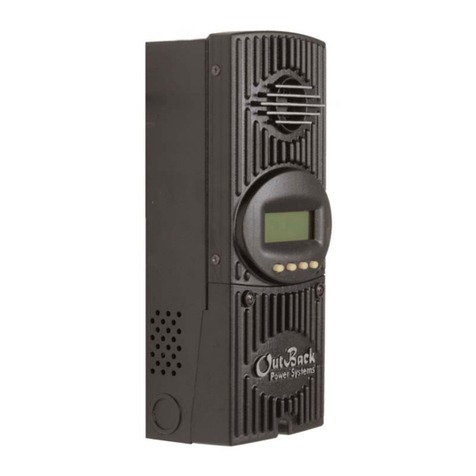
Outback Power Systems
Outback Power Systems MX60 Installation, programming, and user's manual
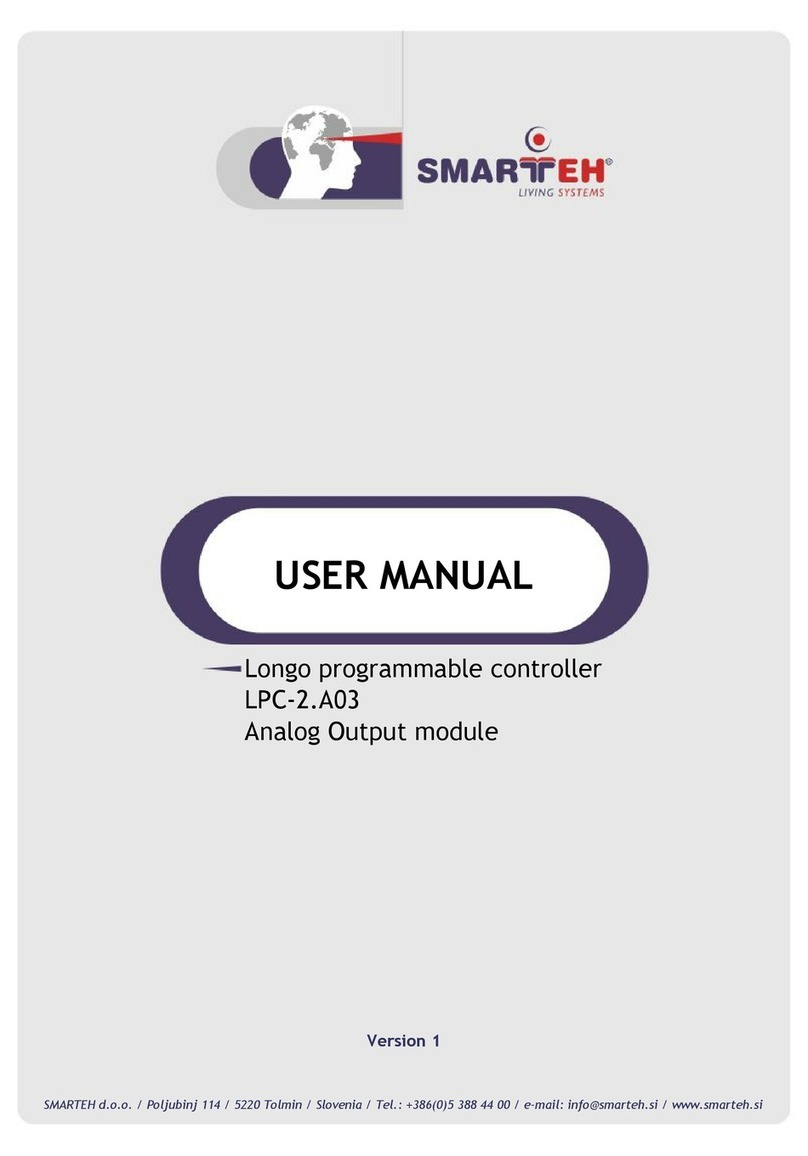
Smarteh
Smarteh Longo LPC-2.A03 user manual
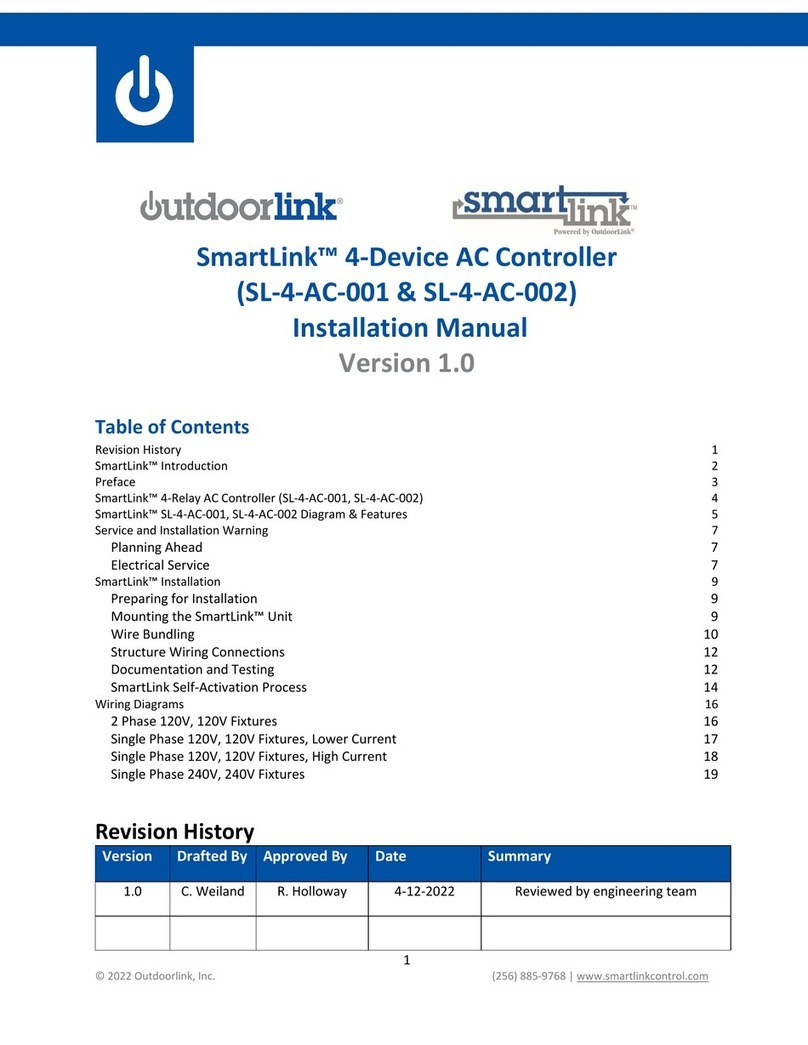
outdoorlink
outdoorlink SmartLink SL-4-AC-001 installation manual
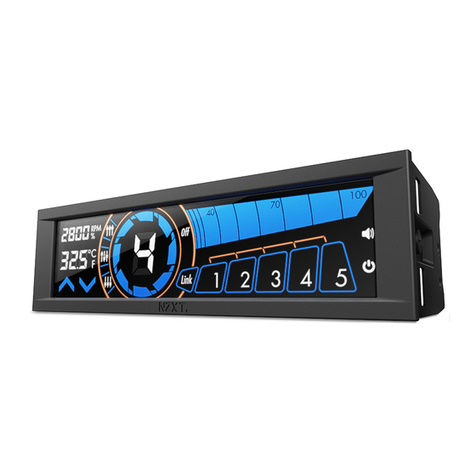
NZXT
NZXT SENTRY 3 user manual

Fröling
Fröling SPS 4000 operating instructions
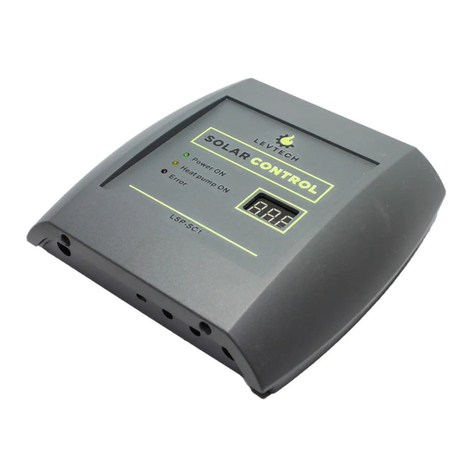
LEVTECH
LEVTECH LSP-SC1 manual

